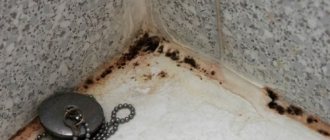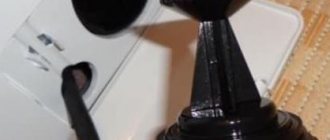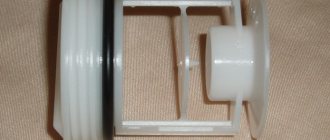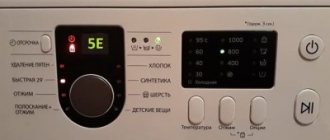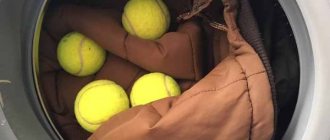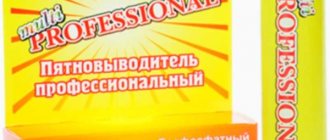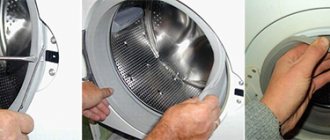How to clean mold from a washing machine - Effective methods
Now that it has been told where mold is hiding and where it comes from in the washing machine, good news awaits everyone.
It's time to tell you how to clean mold from a washing machine. It turns out that you can fight her and easily defeat her. This does not require labor-intensive and expensive means. They are available to everyone and are in every home.
Soda Ash Recipe
This method is effective for those cases when the question is: how to clean the washing machine from the smell of mold. Baking soda is especially good at eliminating odors.
- To do this, a glass of soda is diluted in the same amount of water.
- Apply the mixture to all accessible places inside, on the door and powder compartment.
- After 2 hours, start washing without laundry, in economy mode.
How to clean mold from a washing machine with vinegar solution
Every home has a bottle of vinegar. This is very useful, because the acid will effectively clean even the rubber band of a washing machine from mold. In this case, a 9% concentration is sufficient.
- Just half a glass of liquid is poured into the detergent supply compartment.
- Turn on the mode for heavily soiled white laundry.
- If the device shows that the water has heated to the maximum value, stop washing for 1 hour. Then they start again.
This method is especially useful because it will not only destroy mold in the washing machine, but will also get rid of scale at the same time.
Citric acid will help get rid of mold
It is significant that this food additive is used as a means to clean mold from a washing machine.
- 200 g of the substance is poured into a powder container.
- And they start the wash in the longest and hottest mode.
Cleaning the washing machine from mold using disinfectants from the store
Household chemicals departments sell many products that will help solve the fungus problem.
For example
r, for tiles, which are also prone to plaque. Or liquids and gels for the toilet, which, at the same time as cleaning, fight germs.
- In the concentration indicated on the packaging, the product is applied to places where there is or may be a fungal coating.
- Finally, it is necessary to run the wash cycle at idle speed.
But there is one wonderful, proven and inexpensive remedy for odor in a washing machine with an antibacterial effect. You can buy it at a reasonable price (from the manufacturer) here.
Advice for the most difficult cases
All washing machine mold repellents are good and will usually solve the problem. Well, if that doesn’t work, you’ll have to use copper sulfate.
- 5 g of the substance is dissolved in 1 liter of water.
- Wipe everything inside the washing machine and leave for 3 hours.
- Then turn on the rinse mode, which is best repeated 2 times.
Considering that the chemical is poisonous, processing is carried out with gloves and a respirator.
Interesting on the topic: How to get rid of musty smell in the house and in the country
Fighting methods
You can get rid of mold in your washing machine using store-bought and homemade products. The former act faster and often more effectively (due to the content of aggressive chemical components). Some folk recipes cannot handle serious damage, but if the scale of the problem is small, start with homemade formulations.
Store-bought household chemicals
Every day the market is replenished with new offers with improved formulas
But can all manufacturers be trusted? In order not to spend large sums of money searching for “that” cleaner, pay attention to the rating of proven and popular products
Table 1. Ready-made chemicals
| Name | View | Manufacturer country | Mode of application | Volume, ml | price, rub. |
| "Domestos Universal" | Gel | USA | Apply to the drum, wipe the cuff with a sponge soaked in the product. Leave for 4 hours. Then turn on the rinse mode, followed by a wash at 90° adding citric acid to the tray | 1 000 | 120 |
| "White" | Liquid | Russia | Pour as much bleach as possible into the compartment (the entire bottle) and run a long wash cycle at high temperature. After 2 hours of work, pause (1.5 hours). Continue washing by adding a liter of vinegar to the rinse aid compartment. | 1 000 | 35 |
| "Deo-anti-mold" | Liquid concentrate | Russia | For 5 liters of water, 0.5–1 liter of concentrate is required (treat heavily affected surfaces without diluting). | 1 000 | 170 |
| Cillit Bang | Foam | Great Britain | Removes black mold in 15 minutes. Spray inside the drum, after a quarter of an hour, wipe with a washcloth, turn on the wash | 750 | 300 |
| Neomid | Antiseptic concentrate with water in a ratio of 1:20. | Russia | Antiseptic helps in advanced cases. Apply to problem areas, rinse after 40 minutes | 500 | 535 |
| Savo | Spray | Czech | Eliminates and prevents the appearance of fungus and mold. The active substance acts for 15–20 minutes, then it is washed off with water | 500 | 160 |
| Astonish Mold Mildew | Aerosol | England | The method of application is similar to the previous one | 750 | 270 |
Advice. Using any store-bought mold remover, after the procedure, wipe the tank with a dry cloth and leave the door open for 2 days so that the machine is well ventilated. Wear gloves when handling chemicals.
Home Recipes
On home economics forums you can find many stories about fighting fungus with folk remedies. But if you do not want to join the ranks of word of mouth participants, use ready-made, and most importantly, proven recipes.
Vinegar
Vinegar helps get rid of fungus in the machine by removing salt deposits. Do not use natural apple and grape compositions that may contain dyes and oils - marks will remain on the machine parts. The best option is 9% table vinegar.
Additionally, pour vinegar into the drum itself
Pour 150 ml into the powder compartment, select the maximum temperature and washing mode. When you start spinning, pause it. To eliminate mold, 30 minutes is enough, for limescale – 1.5 hours. After waiting the required time, unpause and complete the cycle. At the last stage, remove and clean the outlet filter, treat the seals, drum, and powder tray with a vinegar solution (50 ml of concentrate per 1,000 ml of water).
Soda
Soda is relevant in cases where minor manifestations of fungus are involved. Prepare a slurry by adding water, and treat the seal lip, drum surface, and cleaning agent bins with this mixture. As a tool, use a toothbrush (for hard-to-reach parts), thin brushes, and dish sponges.
Keep the composition for half an hour to an hour. Finish the process by adding washing powder (1 tbsp) to the tray and starting the machine. At the end of the wash, pull out and dry the outlet filter, wipe all surfaces dry, and ensure the drum is ventilated.
Lemon acid
A safe remedy in the form of a lemon helps remove mold from your car. The effect will be noticeable if the fungus has affected small areas. More often, acid is used as a preventative cleaning once every 3 months or to eliminate musty odors.
For best results, run the machine twice with lemon juice.
Pour 250 g of lemon into a dry powder container and turn on the longest washing program. In this case, there is no need to pause. After the end of the cycle, repeat all the usual steps of removing the filter, wiping parts, rubber, and drum. Do not close the hatch or door until the machine is completely dry.
Method 2: whiteness and Antiscale
Let's look at how to remove mold in a washing machine if there is already a lot of it and it has spread everywhere.
Step 1: Prepare everything you need
|
Step 2: Open the filter
|
Step 3: Wash the filter
|
Step 4: Clean the elastic
|
Step 5: Clean the powder tray and cabinet niche
|
Step 6. Turn on the washing machine
|
Step 7: Inspect the Equipment
|
Step 8. Add Antiscale
|
| Step 9. Check the result Everything is clean and there are no mold spots. Even if there are remnants of fungus somewhere inside, they are dead and do not pose a danger |
Where to begin
To get rid of mold in an automatic washing machine, you first need to find all the places where the fungus could have settled. First of all, inspect:
- tray for detergents and the niche in which it is attached;
- rubber seal (cuff) around the machine hatch;
- drain/fill hoses and their filters;
- drum.
All accessible areas must be cleaned with detergents, a brush and a sponge, and then the surfaces must be treated with special compounds to remove mold. If you use store-bought products, be sure to follow the instructions carefully. By the way, today you can find chemicals on sale that are designed specifically for eliminating fungus from a washing machine.
Vinegar removes scale, plaque, rust and mold. Pour a bottle of vinegar (2-3 glasses) into the drum of the machine, spin to distribute the liquid and run a single wash at the highest temperature possible.To combat mold at home you will need:
- gloves and protective mask;
- rags, sponges and brush;
- vinegar, citric acid and soda;
- chlorine-containing products (“Domestos”, “Belizna” or their analogues);
- laundry soap;
- professional means for eliminating mold (in especially advanced cases).
Mold can also damage the internal parts of the machine, for example, the hoses connecting the tray to the drum. However, inspection of such places should only be carried out by a professional technician.
The procedure for cleaning the external parts of the washing machine is as follows:
- disconnect the machine from the power supply and turn off the water;
- Carefully remove the detergent tray and wipe the niche in which it was located. Rinse the tray of powder residues and clean it with a brush, using chlorine-containing liquids or vinegar. Dry the tray;
- Wipe the seal and door of the washing machine with a damp cloth to remove mold, and then treat them with a sponge soaked in a solution of bleach. You can also use thick soda slurry. In severely advanced cases, you should leave the product to act for a day, and then wipe the parts with a damp sponge, having previously moistened it in a solution of laundry soap. If there is little mold, it is enough to apply the selected composition for 2 hours;
- inspect the drum of the machine. If there are visible signs of mold, wipe the drum with a rag soaked in a solution of laundry soap or bleach;
- unscrew the drain filter and wash its mesh with a brush and detergent;
- unscrew the inlet hose (in some cases you need to use a special wrench for this), remove and clean the inlet filter, if it is present in your washing machine model.
Be sure to inspect the drain filter (debris filter), it can also form mold. (When you unscrew the filter cap, a little water will flow out - this is how it should be.)
The initial cleaning is complete. But getting rid of mold in a washing machine is not easy and external treatment will not be enough. Let's move on to the next stage of eliminating fungus - cleaning hard-to-reach places.
Rules for using the machine to prevent mold from appearing
Washing machine professionals and manufacturers recommend taking preventive measures:
- Wash clothes once a month at 95 degrees. If there is no such clothing, run the program empty.
- Do not get carried away with helium products. Alternate them with regular powders.
- Do not close the hatch after washing. Wipe the drum and seal with a sponge or dry cloth.
- Check the powder container and rinse aid. You can use a product with chlorine or vinegar, they will help get rid of the problem at the initial stage.
- The washing dispenser can be cleaned with a brush and soda if it is not removable.
- Clean your machine regularly with professional descaling products.
- Do not accumulate dirty laundry in the drum; immediately remove wet, clean laundry.
- Inspect the filters and hose and clean them promptly.
In order for devices to work for a long time and not require regular repairs or replacement of parts, you need to monitor their life. Carry out an inspection, get rid of scale and mold, visible and hidden dirt.
As the fungus grows, it covers the parts of the washing machine with a black layer, leaves marks on washed clothes, and spreads an unpleasant odor throughout the room. The machine can be anything (top-loading, usual), but it is more difficult to get rid of mold; it is better to carry out prevention. Under this condition, mustiness will not appear, and you will not have to think about how to get rid of the fungus.
The article has been verified by the editors
Why does fungus appear?
Fungal colonies can grow rapidly, so to successfully combat them you need to understand the causes of the problem:
- High humidity . This refers to both dampness in the room where the unit is installed and in the washing machine itself. An unwashed and undried washing powder container and improper care of the drum and sealing rubber provoke the appearance of mustiness and mold.
- Incorrect use of rinse aid . After washing with fragrances, it is necessary to turn on the unit for an additional rinse. Fabric softener leaves an oily film on surfaces, which serves as a comfortable environment for mold.
- Washing with powders without bleaches . Products with bleaching particles have disinfectant properties - they fight bacteria and fungus.
- Quick wash in cold water . The short mode, beloved by housewives, saves time and electricity, but at the same time harms the device. At low temperatures, the machine remains for a long time without disinfection, and low temperatures contribute to the appearance of mold. Periodically it is necessary to wash things at temperatures not lower than 60 °C.
- Tightly closed lid . There is no ventilation in the drum, the surfaces do not dry out, remaining constantly wet.
Advice! In addition to the universal powder, also buy bleaching powder. It is enough to use it a couple of times a month to keep the machine clean.
Care Tips
In order not to encounter the problem again, you should follow simple rules for operating the washing machine:
- do not close the hatch door and pull out the tray after washing;
- use high-quality washing powders;
- store laundry in a basket;
- run the wash at high temperature at least once a week;
- remove washed laundry immediately, do not leave it in the tank;
- regularly wipe the rubber parts of the machine with an antiseptic solution;
- Clean the tray from any residual detergent.
Simple and affordable means will help you deal with mold in your washing machine. Regular care and cleaning will prevent the fungus from reappearing.
Unexpected outbreak of fungus
Any technical product requires ongoing (after each use) and periodic (scheduled) cleaning of mechanisms and surfaces. As you use it, the hidden cavities of the washing machine remain wet for a long time. They do not have time to dry out and gradually become covered with mold.
Agree, it’s hard to believe that comfortable automatic washing can carry the danger of mold infection. However, this is true.
Optimal conditions for the development of fungus are created if:
- prefer delicate washing;
- rarely wash in hot water brought to 90'C;
- refuse to rinse things because of the pungent odor in vinegar or chlorine solutions that have disinfectant properties;
- use starch-containing conditioners and rinses, the sweetish-aromatic composition of which serves as a useful feed for developing mold spores.
Using clothes washed in a moldy machine is risky. The fabric itself becomes a carrier of mold. Fungi are very tenacious. They are able to reproduce both by spores and vegetatively, through fragments of mycelium or fruiting bodies, as well as sexually (cell fusion). As soon as they touch a body or a food product, they immediately find the strength to gain a foothold in their new habitat. As they develop, they cause poisoning, mycoses, allergic manifestations, bronchitis and asthmatic attacks.
Top 5 chemicals for cleaning rubber parts
If folk remedies don’t help, it’s time to turn to special household preparations. Top 5 products will remove mold or mildew quickly, permanently and inexpensively.
HG
A universal product that removes mold, various types of harmful microorganisms, and unpleasant odors. HG is more often used for cleaning tiles, but it is suitable for rubber and silicone products.
Mode of application:
- apply to mold or mildew,
- wait 1-2 hours,
- wash off with a damp sponge.
Price: from 400 rubles.
Tiret
The combination of affordable price and effectiveness makes Tiret a very popular means for cleaning a washing machine from mold or mildew. The cost of 250 ml is only 200 rubles.
Mode of application:
- moisten the sponge in Tiret and wipe the infected area several times,
- leave for 30-40 minutes,
- rinse with clean water.
Blanidas
Blanidas belongs to the category of professional chemistry. Like HG, it is most often used to clean tiles and tiles, but can also be applied to rubber seals. Price: 400 rubles.
Mode of application:
- soak a sponge in Blanidas and wipe the infected area several times,
- leave for 1-1.5 hours,
- rinse with clean water.
Dr. Beckmann
Good quality product at an affordable price. Cost of Dr. Beckmann is only 300 rubles.
Mode of application:
- fill up the contents of one Dr. package. Beckmann directly into the washing machine drum,
- turn on the “Rinse” mode,
- After finishing work, wipe the inner surface of the drum thoroughly and dry.
Sama
A cheap but high-quality product for removing mold and mildew. In addition to cleansing, it also has a disinfecting effect. Price: 100 rubles.
Mode of application:
- apply to the contaminated surface,
- after 30 minutes, rinse with clean water.
Cleaning products
Both traditional and special detergents from the hardware department of the store are used as a means to clean the washing machine from musty odors, mold and dirt. This process is easy and you can do it yourself. Let's look at popular cleansing products.
Copper sulfate
Copper sulfate can remove the mold itself for a long time, and also get rid of the mold smell in the washing machine. It consists of small blue particles. This powerful poison is used in agriculture when treating against bacteria, so gloves must be used for protection. To prepare the solution, mix copper sulfate, washing powder and water. Apply it to areas where mold accumulates and leave it there for several hours, then use a rinse cycle to remove any residue.
Hydrogen peroxide
A quick and easy way to remove mold is to replace chlorine bleach with 3% hydrogen peroxide. Both when used in medicine it is an antiseptic, and when used in equipment it combats several problems:
- Kills fungus.
- Removes limescale.
- Has an antibacterial effect.
- Destroys viruses.
Using hot water will help remove traces of mold more thoroughly. At the same time, it is safe and does not harm health.
Lemon acid
Citric acid is a commonly used remedy for getting rid of mold. For use, use a couple of packages of acid, which are sold in any market. Place it in the detergent compartment or in the drum, start the washing cycle at a temperature above 90 degrees, preferably with a soaking program. It is recommended to use this method every 4-5 months. Citric acid is great for removing musty smells from your car.
Bleaching
You can clean mold from your washing machine using chlorine bleach. Use it with warm or cold water, as it stops working in hot water. Limescale deposits do not disappear after bleaching and additional measures must be taken. Bleach may not get into the internal parts, so this method is good for light contamination. During cleansing, the product is left for several hours and an additional wash without powder is run at high temperature to remove residual chlorine-containing substances.
Soda
You can clean the washing machine from mold and get rid of the smell inside with soda. Soda is diluted with water to a paste and applied to areas where mold accumulates, leaving this mixture for half an hour. Next, rub the product over the surface with a sponge and start the rinsing mode. More effective cleaning will be when mixing the product with washing powder. Baking soda is good at getting rid of musty odors due to its ability to absorb bad odors.
Vinegar
Vinegar helps clean your washing machine, as does acetic acid. Only use a 9% solution of the product. It is recommended to use a synthetic substance. Apple cider vinegar or wine vinegar may contain oils that will only leave additional residue on the surface of the equipment. After cleaning, the unit must be wiped dry and ventilated well.
Chemicals
The following substances can be used:
- toilet fluid;
- washing powder;
- dishwashing liquid.
Toilet fluid perfectly kills fungus and various pathogens. Apply it to the inside of the machine, rubber surface, powder container. Leave for a few minutes and clean with a sponge. Wipe dry and run an express wash to remove excess substances.
External manifestations of black mold can be removed using the same washing powder and dishwashing detergent. This will not get rid of the fungus and it will begin to appear again. Therefore, other methods need to be used. The method of using cleansing is the same as for any cleaning. It is necessary to thoroughly wash all components of the equipment, then thoroughly rinse, wipe and ventilate the machine. The powder and dish soap are safe for skin and can be used without gloves.
Special products from hardware stores
Many people recommend cleaning your car with products from hardware stores. These products remove three problems at once: dirt, mold and scale.
They appear in the form of sprays, solutions or special powders. They are used both externally and added when washing to the detergent compartment. Cleaning in this way is very effective, but requires additional money. These products can be used for disinfection after washing very dirty items or for cleaning when washing children's clothes.
Where does mold appear?
The growth of fungus on rubber components of automatic machines is usually caused by the following factors:
- Humidity. The household appliance is mainly installed in the bathroom. Regular high air humidity is the main cause of mold. To minimize the development of fungus from inside the drum, you should always open the machine door for ventilation after washing.
- Warm. Black plaque forms faster in warm rooms. In addition, its appearance is stimulated by warm water used for washing.
- Dirt. Bacteria and spores constantly get into the drum of the machine from things. This is a favorable environment for mold development and odor.
If the drum begins to smell unpleasant, and black spots appear in some places, you need to take immediate action. However, before destroying the fungus, it must be found. Sometimes this task causes some difficulties. Mold mainly develops in:
- filter;
- compartment for powder and conditioner;
- on elastic bands inside the drum;
- on the inlet and drain hoses.
The appearance of black mold inside a household appliance should not be ignored. These microspores lead to the development of local and general allergic reactions. In particular, they cause itching, redness of the skin, and peeling. In severe cases, mold can cause Quincke's edema or severe urticaria. In addition, the fungus negatively affects the respiratory system. Regular penetration of spores into the respiratory tract leads to bronchitis, pneumonia, exacerbation or development of bronchial asthma.
The largest amount of fungus accumulates between the rubber bands that separate the porthole from the drum. Small debris often remains here, and the water takes a long time to evaporate. You can clean your washing machine from mold and dirt using folk recipes or using household chemicals.
Facilities
Table 1. How to remove mold from a washing machine.
| Name of the product | More details |
| Folk recipes | |
| Lemon acid | It is recommended to mix citric acid with washing powder in a ratio of 1:2. Dilute the resulting mixture with water to a paste-like state and apply to the affected areas. After 24 hours, rinse off the product with warm water. |
| Copper sulfate | Moisten a soft cloth generously with the liquid. Wipe the elements of the device with a cloth, then wash off with warm water and soap. |
| Household chemicals | |
| White | A quick way to get rid of fungus is to apply Whitening. Mold is “afraid” of chlorine in any form and lags behind literally before our eyes. For safety reasons, it is better to use gloves and a mask. |
Wipe the rubber seal thoroughly. This especially applies to the inside of the component. It needs to be cleaned with a soft cloth wrapped around your finger. Wash the machine door. You can use any detergent: soap, dishwashing gel, glass cleaner. Do the washing
To ensure mold removal, it is important to be sure to run the wash cycle at maximum temperature without pre-loading the laundry. For best results, you can add a little bleach to the water.
How to prevent mold
Yes, you can if you follow simple rules:
- Regularly use the high temperature mode (95 ° C), even if you don’t need to wash anything, run the program idle for a maximum time 1-2 times a month.
- Do not use gel-based laundry detergents; very often the gel settles on the internal drains of the machine and creates a breeding ground for a colony of fungi. Use balms, conditioners, and softeners less often.
- Wipe all accessible parts of the machine with a dry cloth after washing, do not close the lid - let all the moisture evaporate.
- After each wash, remove the powder container, rinse with running water, you can additionally wash with bleach, and dry separately. If the dispenser is not removable, do not push it in and clean it from time to time with soda and an old toothbrush.
- Get rid of scale in a timely manner; the fungus feels quite comfortable in its porous structure. Table vinegar is suitable for removing scale; it is also useful for cleaning the shower stall from limescale.
- Remove the laundry from the machine as soon as the wash is finished.
- From time to time, thoroughly clean the hoses and filters from accumulated dirt; organic residues in the filters serve as a source of infection.
Descaling procedure
Once every six months it is worth descaling with citric acid and vinegar. To do this, pour 1 liter into the powder compartment. vinegar and 400 gr. citric acid. Set the timer to the maximum time, the temperature should exceed 65 C. This procedure simultaneously cleans the machine from scale, pathogenic microflora, fungus and mucous deposits on the internal surfaces of the unit.
Kitchen or bathroom, where to put the machine?
The question is not idle, the whole point is that the bathroom is the darkest and dampest place in the house, so it is not surprising that mold grows in it. In the kitchen, on the contrary, there is at least one window, and ultraviolet radiation, destructive for the mycelium, enters the room. The kitchen is a drier room, which is very good for enamel and parts of household appliances; mold spores are not active in dry air.
There are also disadvantages to placing a washing machine in the kitchen. In our apartments there are very cramped kitchens, and the machine requires a certain space; if the loading is horizontal, then you need space to open the door. A laundry basket can block the aisle or interfere with cooking.
Many housewives also store laundry detergent next to the machine, but this is unacceptable! Since harmful fumes and small particles of powder get into the air and into prepared dishes, the situation is especially sad when there are allergy sufferers in the house.
We recommend placing the machine in the bathroom and installing a forced exhaust (a special fan that directs air from the room to the vent). To prevent mold, it is recommended to keep the door open when no one is using the bathroom. You can also use an effective Chinese remedy that will remove mold in no time.
From time to time you can use an ultraviolet lamp; a 15-minute procedure once a week will help get rid of not only mold, but also all types of microbes that live in large numbers in the bathroom and toilet.
Reasons for appearance
Is mold dangerous or a good neighbor? Research shows that its appearance in an apartment can significantly affect human health.
Normal indoor humidity levels should generally not exceed 80%. If indicators are rising, this is influenced by a number of reasons:
- an abundance of indoor plants;
- lack of proper ventilation in the apartment;
- wet bed linen is dried in the bathroom;
- high indoor temperatures in cold weather outside contribute to the formation of condensation;
- The apartment is heated unevenly.
Household fungus in an apartment occurs primarily in places where moisture accumulates: the bathroom, on the ceilings, behind cabinets, under window sills, etc. If you have already noticed the presence of such a threat in your home, it is worth taking comprehensive measures to eliminate mold before living in the apartment becomes too dangerous.
When to contact a specialist
When independent methods do not work, folk or professional remedies do not help, the smell remains, it is impossible to determine its origin, it is recommended to contact a specialist, he will help get rid of the mold.
A professional will disassemble the automatic washing machine, carefully check the parts, advise which ones are best to replace, and what to pay attention to.
You can find out from a repairman which of the existing methods actually work and which ones spoil and wear out the parts of the washing machine. It is recommended to follow the advice of professionals so that the unit lasts a long time and does not require replacement or expensive maintenance.
